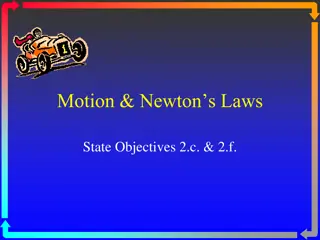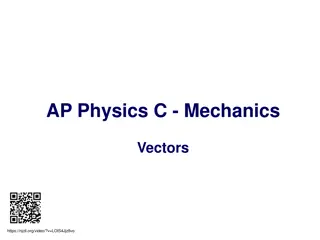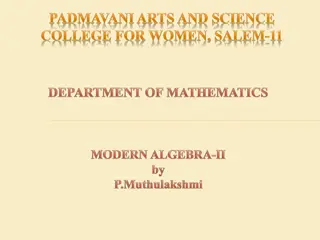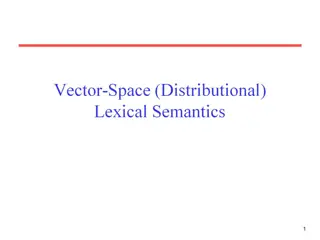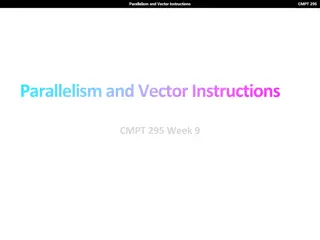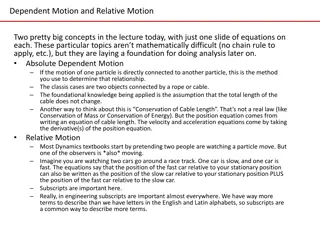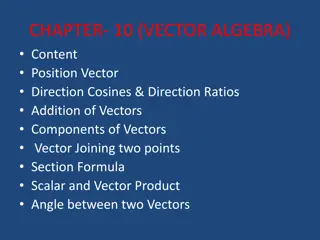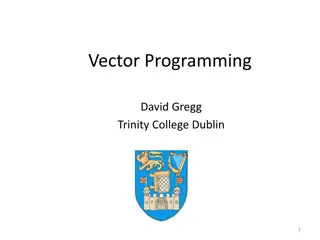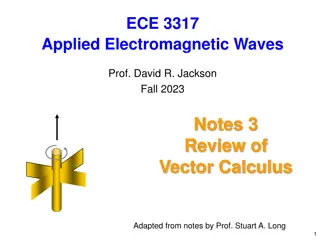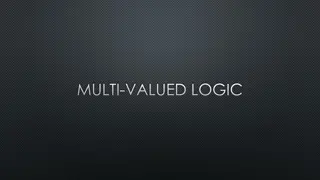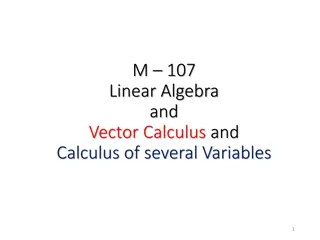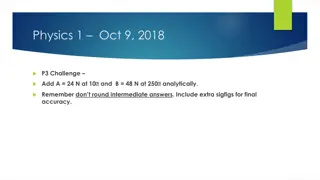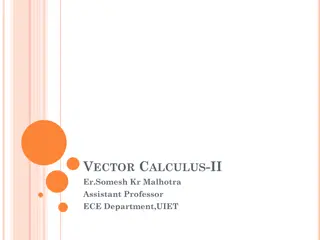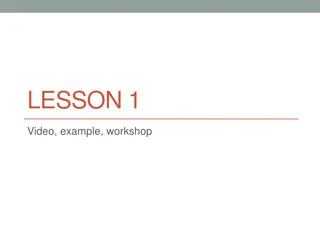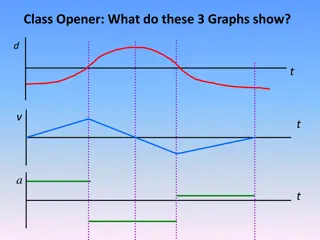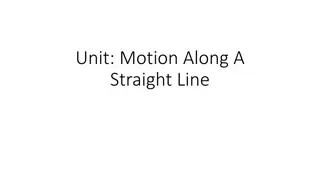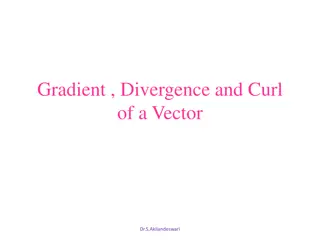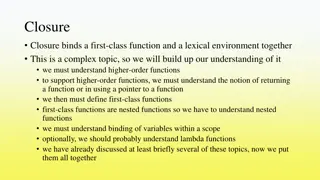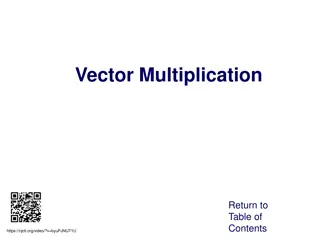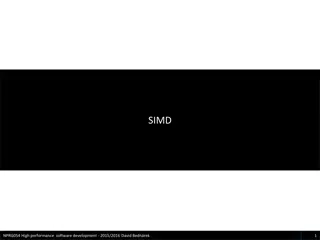Understanding Vector-Valued Functions and Motion in Space
Explore the concept of vector-valued functions and motion in space, including curves, tangents, position vectors, scalar functions, derivatives, and differentiation rules. Learn how to represent curves in vector form and understand the smoothness of a curve based on its derivatives. Gain insights into the domain, components, and differentiability of vector functions in space.
Download Presentation

Please find below an Image/Link to download the presentation.
The content on the website is provided AS IS for your information and personal use only. It may not be sold, licensed, or shared on other websites without obtaining consent from the author. Download presentation by click this link. If you encounter any issues during the download, it is possible that the publisher has removed the file from their server.
E N D
Presentation Transcript
DIYALA UNIVERSITY COLLEGE OF ENGINEERING DEPARTMENT OF COMMUNICATIONS ENGINEERING Mathematics- II ?????????? First Year lecturer Wisam Hayder 2021 1
VECTOR-VALUED FUNCTIONS AND MOTION IN SPACE Curves in Space and Their Tangents When a particle moves through space during a time interval I, we think of the particle s coordinates as functions defined on I: The points make up the curve in space that we call the particle s path. The equations and interval in Equation (1) parametrize the curve. A curve in space can also be represented in vector form. The vector 2
VECTOR-VALUED FUNCTIONS AND MOTION IN SPACE From the origin to the particle s position P( (t), g(t), h(t)) at time t is the particle s position vector (Figure 13.1). The functions , g, and h are (components) of the position vector. the component functions Equation (2) defines r as a vector function of the real variable t on the interval I. More generally, a vector -valued function or vector function on a domain set D is a rule that assigns a vector in space to each element in D. For now, the domains will be intervals of real numbers resulting in a space curve. 3
VECTOR-VALUED FUNCTIONS AND MOTION IN SPACE Real-valued functions are called scalar functions to distinguish them from vector functions. The components of r in Equation (2) are scalar functions of t. The domain of a vector-valued function is the common domain of its components. 4
VECTOR-VALUED FUNCTIONS AND MOTION IN SPACE Derivatives and Motion A vector function r is differentiable if it is differentiable at every point of its domain. The curve traced by r is smooth if dr/dt is continuous and never 0, that is, if , g, and h have continuous first derivatives that are not simultaneously 0. 5
VECTOR-VALUED FUNCTIONS AND MOTION IN SPACE 6
VECTOR-VALUED FUNCTIONS AND MOTION IN SPACE 7
VECTOR-VALUED FUNCTIONS AND MOTION IN SPACE Differentiation Rules 8
VECTOR-VALUED FUNCTIONS AND MOTION IN SPACE Integrals of Vector Functions; Projectile Motion Integrals of Vector Functions 9
VECTOR-VALUED FUNCTIONS AND MOTION IN SPACE 10
The Vector and Parametric Equations for Ideal Projectile Motion To derive equations for projectile motion, we assume that the projectile behaves like a particle moving in a vertical coordinate plane and that the only force acting on the projectile during its flight is the constant force of gravity, which always points straight down. We assume that the projectile is launched from the origin at time t=0 into the first quadrant with an initial velocity ?0 (Figure 13.10). If ?0makes an angle with the horizontal, then 11
VECTOR-VALUED FUNCTIONS AND MOTION IN SPACE FIGURE 13.10 (a) Position, velocity, acceleration, and launch angle at (b) Position, velocity, and acceleration at a later time t. 12
VECTOR-VALUED FUNCTIONS AND MOTION IN SPACE 13
VECTOR-VALUED FUNCTIONS AND MOTION IN SPACE 14
VECTOR-VALUED FUNCTIONS AND MOTION IN SPACE A projectile reaches its highest point when its vertical velocity component is zero. When fired over horizontal ground, the projectile lands when its vertical component equals zero in Equation (5), and the range R is the distance from the origin to the point of impact. 15
VECTOR-VALUED FUNCTIONS AND MOTION IN SPACE 16
VECTOR-VALUED FUNCTIONS AND MOTION IN SPACE The next example shows how to account for another force acting on a projectile, due to a gust of wind. We also assume that the path of the baseball in Example 5 lies in a vertical plane. 17
VECTOR-VALUED FUNCTIONS AND MOTION IN SPACE 18
VECTOR-VALUED FUNCTIONS AND MOTION IN SPACE (b) The baseball reaches its highest point when the vertical component of velocity is zero, or Solving for t we find Substituting this time into the vertical component for r gives the maximum height That is, the maximum height of the baseball is about 45.2 ft, reached about 1.6 sec after leaving the bat. (c) To find when the baseball lands, we set the vertical component for r equal to 0 and solve for t: The solution values are about t=3.3 sec and t=-0.06 sec Substituting the positive time into the horizontal component for r, we find the range R = (152 cos 20 - 8.8)(3.3) = 442 ft . Thus, the horizontal range is about 442 ft, and the flight time is about 3.3 sec. 19
VECTOR-VALUED FUNCTIONS AND MOTION IN SPACE Arc Length Along a Space Curve One of the features of smooth space and plane curves is that they have a measurable length. This enables us to locate points along these curves by giving their directed distance s along the curve from some base point, the way we locate points on coordinate axes by giving their directed distance from the origin (Figure 13.12). This is what we did for plane curves in Section 11.2. To measure distance along a smooth curve in space, we add a z-term to the formula we use for curves in the plane. 20
VECTOR-VALUED FUNCTIONS AND MOTION IN SPACE 21
VECTOR-VALUED FUNCTIONS AND MOTION IN SPACE EXAMPLE 1 A glider is soaring upward along the helix r(t)=(cos t)i + (sin t)j + tk How long is the glider s path from t = 0 to t = 2 ? 22
VECTOR-VALUED FUNCTIONS AND MOTION IN SPACE 23
VECTOR-VALUED FUNCTIONS AND MOTION IN SPACE 24
VECTOR-VALUED FUNCTIONS AND MOTION IN SPACE 25
VECTOR-VALUED FUNCTIONS AND MOTION IN SPACE Unit Tangent Vector We already know the velocity vector ? = Vector ?? ?? is tangent to the curve r(t) and that the is therefore a unit vector tangent to the (smooth) curve, called the unit tangent vector (Figure 13.15). The unit tangent vector T is a differentiable function of t whenever v is a differentiable function of t.As we will see in Section 13.5, T is one of three unit vectors in a traveling reference frame that is used to describe the motion of objects traveling in three dimensions. 26
VECTOR-VALUED FUNCTIONS AND MOTION IN SPACE 27
VECTOR-VALUED FUNCTIONS AND MOTION IN SPACE 28




